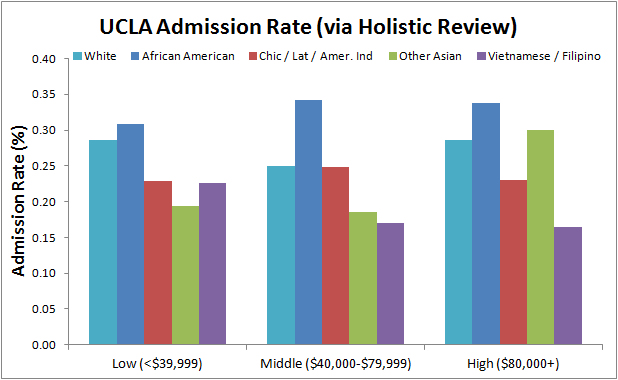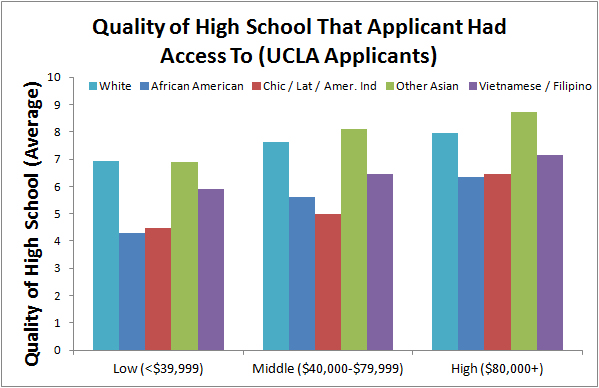Earlier this week, The Daily Caller — a national conservative website — reported on the work of UCLA professor Tim Groseclose. Groseclose is a conservative-leaning professor of political science at UCLA, and he recently set out to prove a very specific and inflammatory charge: that UCLA’s post-Proposition 209 holistic review process was actually race-based. In a book called “Cheating: An Insider’s Report on the Use of Race in Admissions at UCLA“, Groseclose presents his data purporting to demonstrate widespread use of holistic review to make determinative decisions in favour of minority applicants to UCLA. The Daily Caller summarized Groseclose’s findings as follows:
[Groseclose claimed] that the research is proof that UCLA accepted more black students than if they had followed the law, which negatively impacted white and Asian applicants.
He claims that the racial preferences were used when the university would review applications that were marked for further consideration. In those instances, black applicants with incomes over $100,000 were around twice as likely to be accepted than white and Asian applicants with incomes of $30,000 with similar test scores.
Groseclose’s charges are pretty serious: he alleges that UCLA is violating state law. But, two things also make this article particularly interesting: 1) Groseclose made the full dataset he received from UCLA’s admissions departments available, and 2) he makes a testable hypothesis.
Groseclose’s book is not peer-reviewed and even before embarking on this analysis, I noted some incorrect statements made by the DailyCaller article. So, I took it upon myself this morning to download Groseclose’s dataset and test his central assertion — that UCLA’s holistic review process is covertly race-based affirmative action — myself. Sufficed to say, Groseclose’s conclusion did not hold up.
Hypothesis
So, for those of you a little fuzzy on your scientific method, you start by generating a hypothesis and distilling that larger hypothesis into a few testable predictions. Groseclose’s central hypothesis is that UCLA’s holistic review process is a race-based anti-White and anti-Asian affirmative action program that violates Proposition 209.
If this hypothesis turns out to be true, than we would predict (based on the assumption that holistic review is attempting to depress admission of “undesirable” or “overrepresented” students):
- Low-income minorities should have the highest admission rate under holistic review.
- High-income Whites and Asians should have the lowest admission rate under holistic review.
- Black, Chicano, Latino, and Native students who receive holistic review should be admitted at higher rates than White and Asian students
Methodology
Data for over 120,000 applicants to UCLA were considered during a three-year period that Groseclose contends included a racist holistic review process. Additional applicants for whom race and/or family income level were not available were excluded from my analysis.
Applicants were split (mostly for the sake of data presentation) by family income into low (<$39,999), middle ($40,000 – $79,999), and high ($80,000+) groups, and then analysed by race. Admission rates under holistic review is calculated as [number of applicants who received admission after holistic review] / [number of applicants who received holistic review]. I am constrained by the racial groups disclosed to Groseclose — for some unknown reason, Chicano/Latino/American Indian were not disaggregated, and only Vietnamese/Filipino was disaggregated from a group labelled “Other Asian”.
Results
Consistent with my earlier analysis of total admission rate trends in UC schools, post-Proposition 209 admission rates heavily favour White and Asian applicants, regardless of family income level: underrepresented minority applicants are admitted at far lower rates than their White and Asian peers at all economic levels.
The group that enjoys the most obvious preference under the post-Proposition 209 system are high-income Asian Americans; nearly 30% of Asian Americans applying from families making $80,000 or more receive an offer to attend UCLA, and the highest rate of admission for any racial and economic group are Asian Americans whose families earn $100,000 or more.

Given Groseclose’s hypothesis that UCLA’s holistic review process has been engineered to depress admissions for those most well-represented on-campus, we should predict that holistic review should strongly disadvantage Whites and Asians. Yet, that doesn’t turn out to be the case.

Although African American applicants appear to have slightly higher admission rates under holistic review, other minority applicants do not. In fact, in regard to most underrepresented minorities — Chicanos, Latinos, Native Americans, Vietnamese and Filipino Americans — holistic review at UCLA seems to be largely failing to do anything at all.
In addition, admission rates for Black students under holistic review are largely similar to that of White students in most of the income groups (only in the middle income group does the rate to be significantly higher for African American applicants relative to other applicants). At the low-income level, Whites and African American applicants have a virtually identical admission rate under holistic review, suggesting that African Americans are not deriving a specific race-based preference.
At the high-income level, African American students appear to be admitted at slightly higher rates, but this is actually misleading. White students making $100,000+ are flagged for holistic review (but then not admitted) at an unusually high rate; admission rates under holistic review for this subset of applicants is an outlier and very low. With a 40% admission rate under holistic review, White students whose families make $80,000 – $99,999 are actually being admitted at the highest rate for those income levels.
In addition, at the high-income level, Asian Americans are admitted under holistic review at rates similar to African American applicants from the same family background.
This statement by Groseclose:
[B]lack applicants with incomes over $100,000 were around twice as likely to be accepted than white and Asian applicants with incomes of $30,000 with similar test scores.
… could not be replicated (although to be fair, I could not apply the “with similar test scores” qualification since that part of his methodology was unclear without reading the book). However, it is worth noting that all applicants admitted to UCLA — with or without holistic review — had very similar GPAs.
Conclusion
When analysed comprehensively, Groseclose’s own dataset strongly refute his hypothesis that holistic review at UCLA has been engineered to violate Proposition 209 and disadvantage White and Asian students. While African American students are admitted at reasonably high rates under holistic review, other underrepresented minorities are not. In addition, the rates at which African American students are admitted under holistic review are comparable to the admittance rates of Whites at all income levels, and to non-Southeast Asian Americans at high-income levels.
If UCLA has instituted an illegal race-based holistic review process to circumvent the state’s affirmative action ban and artificially recruit underrepresented minorities to their school over White and Asian students, they are doing a pretty piss-poor job of it since they would have created a system that lets in Whites and Asians at roughly the same rates as Blacks, and that fails to admit non-Black underrepresented minority students at any significantly comparable rate at all.
In short, the calculated admission rates fail to follow the trends we would predict based on Groseclose’s own hypothesis, and therefore Groseclose’s hypothesis is incorrect. Scientific method, for the win.
Bonus data
There is one really great observation that arises out of Groseclose’s dataset. Those who assert that it is class, not race, that most matters in creating the education disparities that impact college admissions should take special heed.
In California, all high schools receive a general grade on a 1-10 scale that ranks the quality of the school against all others. A 10 score on that scale is an especially high-quality school; a 1 is a failing school. (Clarification: I’ve been asked in multiple outlets how this is calculated. Every year, the California Department of Education generates a ranking out of ten of all high schools based on their percentile ranking of a score called the Academic Performance Index (API); it is this measure that is used to assess school performance and provide monetary incentives to high-performing schools. You can learn more about the API score here, specifically the executive summary sheet here. The API index, which depends in part on year-long improvement of student performance on standardized tests, is not without controversy; however, for several reasons, it is also the most widely-used metric for state–wide comparisons of high school quality and learning environments in California.)
If we calculate the quality of high schools that students have access to based on race and class, we arrive at the only graph one ever needs to demonstrate the insidious impact of race and racism in America.
Take home message? Poor Whites and Asians still have access to a better-quality high school education than rich Blacks, Chicanos, Latinos and Native Americans.


